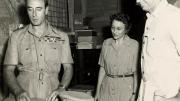Students referred to her as formidable, using the French pronunciation. Friends called her “Ropy”—“Radcliffe’s Only Professor.” But Cora Du Bois, in fact, wasHarvard’s first tenured female professor in the Faculty of Arts and Sciences, thanks to a bequest that linked the two institutions long before they officially merged: a gift to Radcliffe College to hire an eminent woman scholar to hold the Zemurray Stone Radcliffe professorship at Harvard. (From 1949 to 1954, for a trial period without tenure, medievalist Helen Maud Cam held the post.) Though her appointment in 1954 was in anthropology at Harvard, Du Bois was expected to fulfill obligations at Radcliffe, too.
As the first woman to inhabit a professorial office in the Peabody Museum, Du Bois by her very presence produced small cracks in what had essentially been a century-long male club of eminent anthropologists. She liked to smoke, which required descending from her fourth-floor office to the official smoking room in the basement where she joined her male cohort. Integrating the Faculty Club was more difficult: initially, Du Bois had to enter by a back door and dine apart from the main dining room reserved for men.
She was used to gender imbalances. In World War II, recruited into the Office of Strategic Services as a Southeast Asia expert, she rose to direct research and analysis for its headquarters in Ceylon (now Sri Lanka) and worked closely with mostly male intelligence and military officers, including Lord Louis Mountbatten, the British supreme commander. (Two subordinates, Julia McWilliams [Child] and Paul Child, became lifelong friends.) After the war, she joined the State Department’s office of intelligence research as chief of its South East Asia branch—again, as a lone woman.
Her upbringing had not prepared her for these “first woman” positions: her Swiss entrepreneur father and first-generation German-American mother undervalued her intellect, curiosity, and ambition. But an inheritance enabled her to attend Barnard, where an anthropology course taught by Franz Boas and Ruth Benedict, assisted by Margaret Mead, changed her life. Despite Boas’s “mystifying” lectures on Eskimo language and myths and Benedict’s “painful stammer and curiously inappropriate dresses, I was snagged,” she recalled. In Benedict’s lectures she discovered “a vision of the human condition and world view that contrasted with the culture-bound history to which I had been exposed.”
After graduate study at Berkeley, she returned east in 1935 to work at the Boston Psychopathic Hospital and with Henry A. Murray at Harvard. Along with Benedict, Mead, and a few others, she became a leader in the 1930’s “culture and personality” movement that explored the potential impact of culture on the psyche. Two years of fieldwork on a remote island of Indonesia, where she lived alone with former headhunters, resulted in a comprehensive ethnography, The People of Alor (1944), that cemented her reputation as a pioneer in psychological anthropology and thrust her into government service. Asian specialists knew of her work, and after Pearl Harbor, Du Bois was swiftly summoned to Washington, D.C.
“It behooves us to…use our new powers with judicious and constructive wisdom.”
By now a self-made woman with a commanding personality to match her keen intellect, she became famous for acerbic cables (as she was later renowned for trenchant remarks on student papers). She was equally blunt at the State Department in trying to educate government and military officials about the rapid changes under way in South and Southeast Asia after the collapse of European colonialism. “The US is now heir to whatever is left of western influence in the area,” she said in a 1949 speech to the U.S. Army’s Strategic Intelligence Division. “It behooves us to approach this region with more knowledge than is generally current in the US on the Far East and even more importantly to use our new powers with judicious and constructive wisdom.” But Cold War politics prevailed and the United States became embroiled in Vietnam.
World War II, meanwhile, had changed her orientation to anthropology. At Harvard, Du Bois focused on processes of sociocultural change and incorporated her broad expertise into seminars and interdisciplinary courses. “Peoples and Cultures of India” and “Peoples and Cultures of Southeast Asia: The Buddhist World and the Islamic World” introduced students to geography, linguistics, and the prehistory of these diverse regions as well as to contemporary history, economics, politics, religion, philosophy, and kinship.
Despite her courses’ relevance to current events, she refrained from political discussions with students about U.S. involvement in Vietnam. Having given advice in the State Department, she had moved on. But when the CIA sought prospective researchers in Southeast Asia, she advised colleagues privately that anthropological research should never be used as a cover for intelligence work.
She stood by the same principle when leading the American Anthropological Association and the Association of Asian Studies during that turbulent period, and in her research in the 1960s and ’70s. Her main project involved a 12-year study of Bhubaneswar, an ancient Hindu temple town becoming a capital for the new Indian state of Odisha. Disciplines from anthropology and sociology to religion and urban planning were represented, and doctoral advisees included both Indian and American students. Tough, outspoken, principled, but always compassionate, Du Bois was challenging to some, a guardian angel to others.










